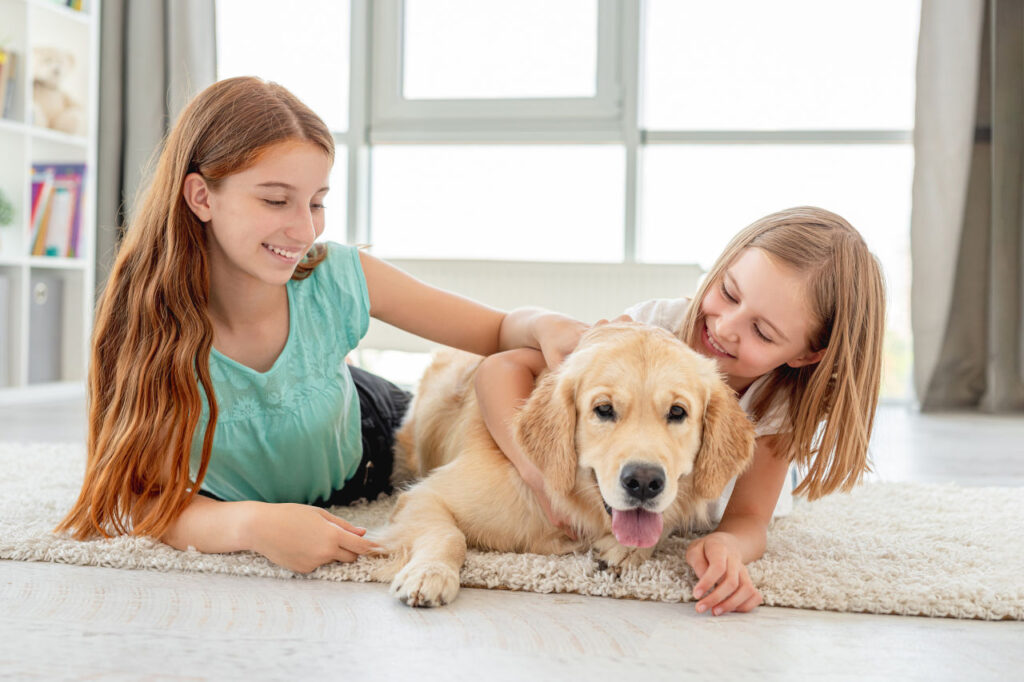Dogs in schools: animal mediation to care for pupils
Oasis, Pixel, Naya, Platon and Silou are not the new acronyms that the French education system is so fond of, but the names of 5 Golden Retrievers who have been working for a number of years in schools piloting animal mediation.
Sylvain Wagnon, University of Montpellier and Laura Nicolas, Université Paris-Est Créteil Val de Marne (UPEC)

Although this practice is relatively recent in schools, it has a long history in the medical field, and the presence of animals has proved to be a major asset for people with dependencies or disabilities, not only in physical, physiological or preventive terms, but also as apedagogical and socialization tool.
The current interest in this educational approach underlines the emergence of a new way of looking at animals and a new way of thinking about education. The practice of introducing pets into school environments is already producing significant results in terms of student well-being, school climate and learning.
Benefits for children's social skills
The presence of animals in the classroom is subject to regulations, but also to a knowledge of animal protection. In the case of animal mediation, the animals used are pets, and there is no legal prohibition in the Education Code concerning their presence in schools.
The law of July 30, 1987 gives guide dogs for the blind or assistance dogs accompanying people with disability cards access to places where they can work, train or educate. The law of November 30, 2021 aimed at combating animal mistreatment and strengthening the bond between animals and humans enables experiments to be carried out in schools, which, as they develop, give rise to an initial institutional framework.
Research into children and animal mediation by François Beiger, Marine Grandgeorge and Céline Barrier has demonstrated the benefits of the relationship between animals and children. The results of other scientific research focusing more specifically on the presence of an animal in the classroom show that the effects are highly positive for children's well-being and development.
Firstly, pets can help children develop social skills, better manage anxiety and encourage empathy. By playing with an animal, children learn to care for others and communicate with their peers.
Pets also help children to relax, concentrate and better understand their own feelings. Indeed, children are encouraged to be more attentive to the beings around them, and to better understand how they feel when they interact with an animal.
[More than 85,000 readers trust The Conversation newsletters to help them better understand the world's major issues. Subscribe today]
Last but not least, this type of interaction promotes problem-solving skills. Teachers can incorporate activities involving pets into their school curricula to help students succeed, and to foster exchanges, oral expression, reading and self-confidence. Animal mediation can thus be chosen as a common thread for learning throughout a project.
Taking into account the animal's point of view
Whatever the location and target audience, animal mediation involves at least three players: the beneficiary(ies), the facilitator - often the teacher in the classroom - and the animal chosen for its particular qualities linked to the context. In most observations, it's the benefits for the beneficiaries that are studied. This anthropocentric view needs to be broadened to consider the well-being of each of the protagonists.
Thanks to a better understanding of the physiological and psychological needs of animals, their well-being is now being taken into account in mediation situations. The animal is no longer just an effective partner in children's development, but is considered for its own sake as a sentient being with affects directly linked to interactions with the child or children. Taking this point of view too is essential to ensure coexistence and positive interactions for all.
The classroom can be a noisy place, and the children's demands on the animal can tire and stress it. The teacher needs to be alert to signs of discomfort and offer the animal a place to retreat, respected by the children. Each animal is a special individual, and this uniqueness is something to be discovered with the children. Beyond general knowledge of the needs of the animal species chosen to share the classroom, it's daily life alongside it that will enable us to discover its character, its preferences and what bothers it.
Marie-Laure Laprade, a school teacher and president of the association Éducation Éthique Animale, promotes animal mediation in schools, while making a number of recommendations:
"In order for the animal invited into the classroom to flourish, it's crucial to ask about the biological and behavioral needs of its species, to learn about the particular history of this particular individual, and to learn how to decipher its expectations, preferences, attitudes and reactions. It's a real apprenticeship in "living with". I therefore have serious reservations about bringing an animal into the classroom unless the project is carefully prepared in advance, with the animal and the pupils at the heart of the project.
Respecting certain rules and paying careful attention to the partner animal are therefore essential if this experience is to be beneficial to all, while at the same time setting limits to the generalization of this practice.
If we are to move beyond the initial experiments, while at the same time ensuring that the practice does not become too widespread, we need to train individuals - both teachers and the animals themselves - as is the case in some other countries. A number of schemes are beginning to be set up at academy level.
Sylvain Wagnon, Professor of Education, Faculty of Education, University of Montpellier and Laura Nicolas, Senior Lecturer in Language and Educational Sciences, Université Paris-Est Créteil Val de Marne (UPEC)
This article is republished from The Conversation under a Creative Commons license. Read theoriginal article.